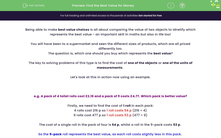Being able to make best value choices is all about comparing the value of two objects to idnetify which represents the best value - an important skill in maths but also in life too!
You will have been to a supermarket and seen the different sizes of products, which are all priced differently too.
The question is, which one should you buy which represents the best value?
The key to solving problems of this type is to find the cost of one of the objects or one of the units of measurements.
Let's look at this in action now using an example.
e.g. A pack of 4 toilet rolls cost £2.16 and a pack of 9 costs £4.77. Which pack is better value?
Firstly, we need to find the cost of 1 roll in each pack:
4 rolls cost 216 p so 1 roll costs 54 p (216 ÷ 4)
9 rolls cost 477 p so 1 roll costs 53 p (477 ÷ 9)
The cost of a single roll in the pack of four is 54 p, whilst a roll in the 9-pack costs 53 p.
So the 9-pack roll represents the best value, as each roll costs slightly less in this pack.
You may think that this is often the case, and that larger packs usually represent better value.
However, this is not always true.
For example, a smaller pack may be on special offer (which reduces the price of each unit) whilst the larger pack is not.
So be careful to not jump to conclusions, and always calculate before you make any decisions.
In this activity, we will find the costs of single units within larger packs so that we can compare prices and decide which options represents the best value purchase.








